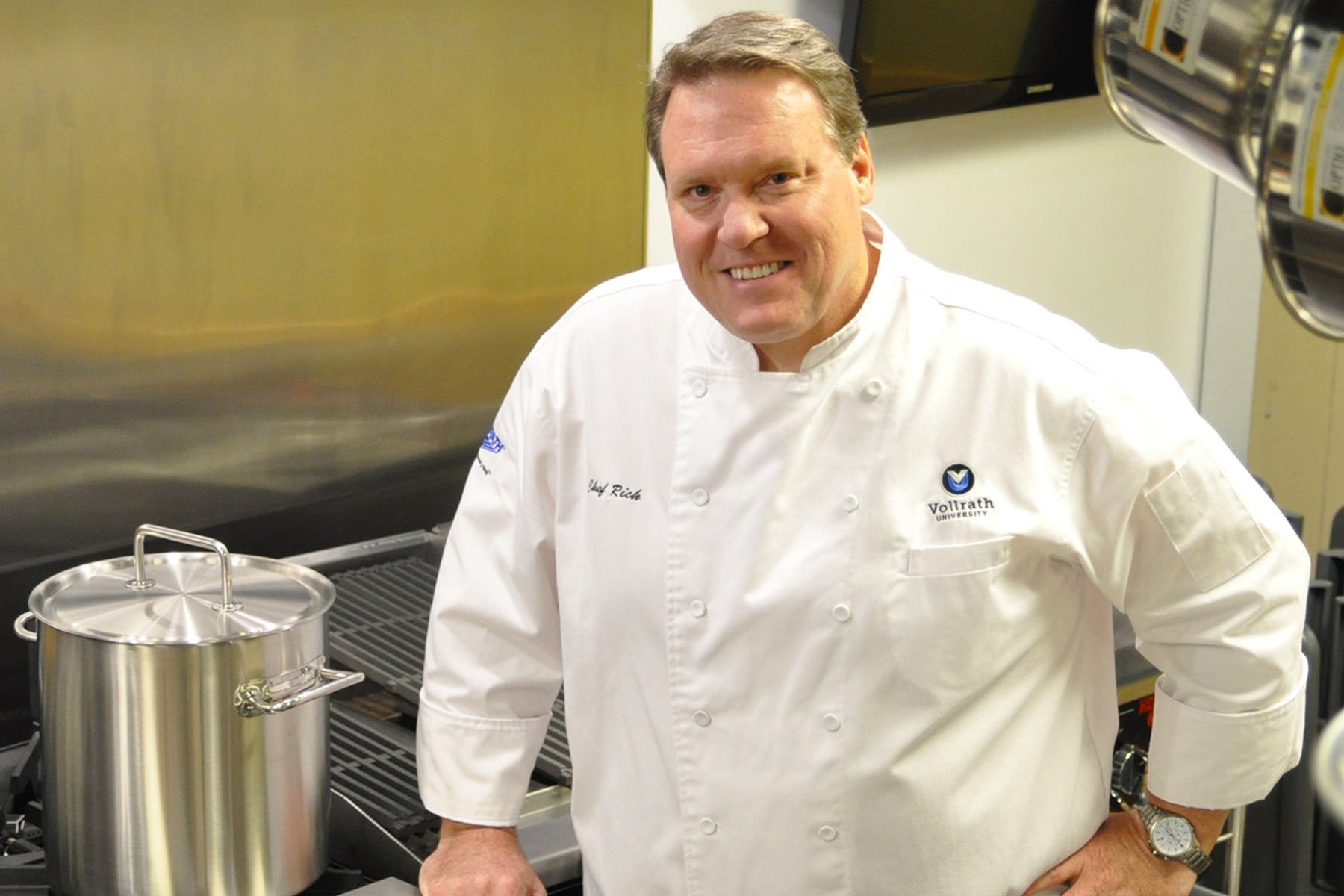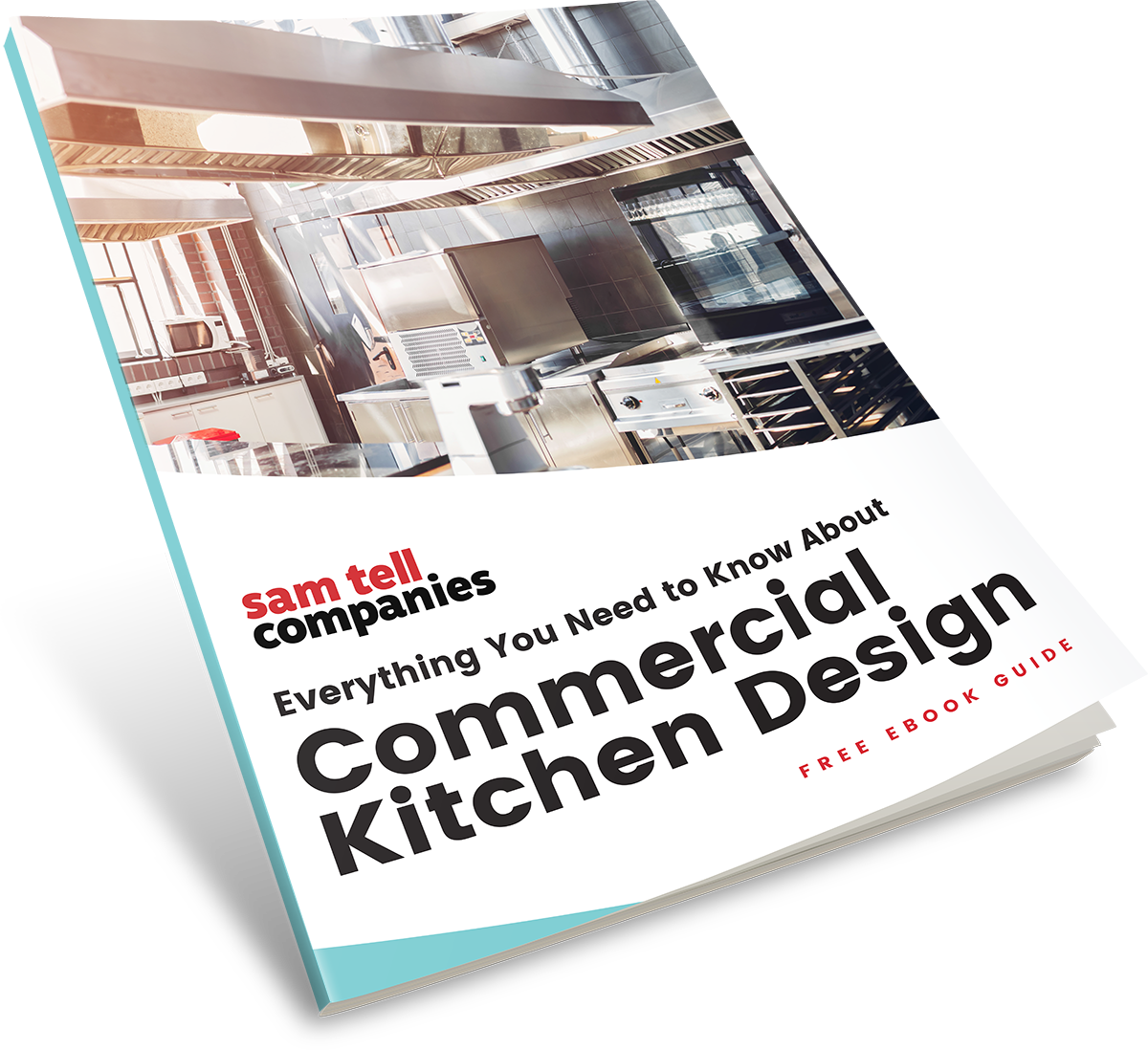Chef Richard Rupp emerged in the restaurant industry with a degree in hotel restaurant management and a goal to lead the kitchen at Rupp’s, his family’s supper club in Sheboygan, WI. When that plan didn’t quite pan out, he decided to try something different.

“I love when customers call and ask for advice on how equipment works and in general how to solve problems when cooking,” says Chef Rupp. “That’s fun to me. My experiences in the culinary world are still incredibly useful to me. I just use that knowledge in a different way than being in the day-to-day operations of a restaurant.”
Chef Rupp joined us recently to dig through the cookware cabinet to talk about everything from induction cooking, cast iron, and stainless steel, to the one piece of kitchen equipment that he absolutely loves cannot live without. Here’s our interview:
Sam Tell: If you were opening a new restaurant today, what types of cookware would you absolutely must have on hand?
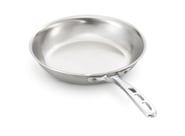 Chef Rupp: It all really starts with your menu. You have to look at your menu. But in general, if I needed a utility pan that I could do so many things with, it’s the 10-inch fry pan. That’s our most popular item and most versatile product. It’s the one pan that you can do everything in.
Chef Rupp: It all really starts with your menu. You have to look at your menu. But in general, if I needed a utility pan that I could do so many things with, it’s the 10-inch fry pan. That’s our most popular item and most versatile product. It’s the one pan that you can do everything in.
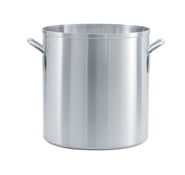 And then you get into the products you need when you’re trying to be specialized in what you do. For example, a sauce pot. It’s wide and short, to allow for evaporation, which helps when you want to reduce a sauce. And that’s the difference between a sauce pot and a stock pot. A stock pot is taller than it is wide, which helps you retain liquids when you're trying to extract flavors through the boiling or simmering process. Sauce pots, sauce pans, and everything else, all of those things have a special purpose to them.
And then you get into the products you need when you’re trying to be specialized in what you do. For example, a sauce pot. It’s wide and short, to allow for evaporation, which helps when you want to reduce a sauce. And that’s the difference between a sauce pot and a stock pot. A stock pot is taller than it is wide, which helps you retain liquids when you're trying to extract flavors through the boiling or simmering process. Sauce pots, sauce pans, and everything else, all of those things have a special purpose to them.
Materials in today’s world are so important. Aluminum, for example, is a great piece of cookware, but it doesn’t work on induction. So, as more and more people move to induction cooking, you have to understand what types of materials you need.
ST: What is induction cooking and what type of cookware do you need for it?
CR: Induction cooking uses magnetic energy in the cooking process. So what induction does is it pushes the molecules against each other, or rubs them against each other, which creates resistance and heat. It’s like when you're cold and you rub your hands together—that friction creates heat. With induction, the heat is not created in the induction range, it’s created in the cookware. So, good quality magnetic cookware is what you need for induction cooking.
.jpg?width=763&name=BRA_4-SeriesInductionRange_B6I06410698%20(1).jpg)
For good quality, you want a magnetic piece of steel. And most steel cookware in the industry is induction capable. And in the industry, cookware often comes with clads, or different pieces of material, built into the steel cookware. Aluminum is most commonly used in these clads because aluminum can spread heat very evenly.
ST: What are the advantages of induction cooking?
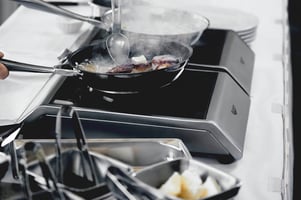 CR: Induction is such a great piece of equipment right now because it’s energy efficient. When you get rid of that open flame of a traditional gas burner, it saves money. Plain and simple. It’s just more efficient to use an electric burner than it is to use a gas burner. It also helps cool a kitchen down. It used to be that you'd have to work in a kitchen with no air conditioning and a 10-burner stove—it made for a very long, hot day. Now you can run a cooler, more comfortable kitchen that’s also a lot more safe.
CR: Induction is such a great piece of equipment right now because it’s energy efficient. When you get rid of that open flame of a traditional gas burner, it saves money. Plain and simple. It’s just more efficient to use an electric burner than it is to use a gas burner. It also helps cool a kitchen down. It used to be that you'd have to work in a kitchen with no air conditioning and a 10-burner stove—it made for a very long, hot day. Now you can run a cooler, more comfortable kitchen that’s also a lot more safe.
ST: What do you say about induction units to people who love their gas ranges?
 CR: Gas always had this romantic ideal to it, right? Everyone thought that having a big gas range in your home or restaurant was the way to go. And I did too. I bought a house, my wife and I put a brand new, giant gas range in there. I had bad experiences with older types of electric ovens, so I thought gas was the answer. Let me tell you, the first time I used that big gas range, I thought, “oh no, what did I do?”
CR: Gas always had this romantic ideal to it, right? Everyone thought that having a big gas range in your home or restaurant was the way to go. And I did too. I bought a house, my wife and I put a brand new, giant gas range in there. I had bad experiences with older types of electric ovens, so I thought gas was the answer. Let me tell you, the first time I used that big gas range, I thought, “oh no, what did I do?”
A few weeks later, we bought an induction range. And it’s so much better than those old electric stoves. Oftentimes with electric, especially those home stoves that have the coil under the glass, they pulse, so low heat isn’t really low heat. It’s either 100 percent on or it’s 100 percent off. The biggest advantage with induction is that our new ranges that just came out have that steady low setting—when you turn it down, it is a steady low power. And that’s very important if you’re trying to work with sugars or chocolate, because when the old electric ranges pulse, they cool. And if you don’t have a steady, low heat, you’re constantly having to rotate the product into the heat to keep it liquid or melted.
.jpg?width=763&name=PRO_4-series-chocolate_gl_2020-01-09.2%20(1).jpg)
The accuracy with induction is a major advantage. You turn to a set number and boom, you’re there at the heat level you want, every time. With gas, what is medium? It’s a lot more difficult to judge medium vs. low vs. high with a gas range than with an induction cooktop.
ST: Let’s talk about specific types of cookware. Cast iron pans are incredibly popular. Is the hype overblown or do cast iron pans have a well-earned reputation for kitchen greatness?
CR: I think there’s something to the cast iron hype. Cast iron has a property called “emissivity.” What that means is when it gets hot, it stays hot and it releases that heat at a more even rate than other types of cookware. A good way to think of it is if you put two pieces of cookware—aluminum and cast iron—next to each other on a counter, you can feel the heat coming off of the cast iron, while the aluminum loses its heat much more quickly. Aluminum cools fast, but cast iron really retains that heat. Cast iron also has this emotional element to it as well. You have an old cast iron and it makes you think about grandma’s house and there’s definitely an appeal to that feeling.
ST: When is it appropriate to use stainless steel cookware? What are the advantages to cooking with stainless steel?

CR: There’s the standard piece and that’s what we would call at Vollrath our Standard Select. It’s best suited for a stock pot or a sauce pot when you’ve got a large amount of liquids and all you’re trying to do is cook it. Stainless steel truly shines because it doesn’t react with food. Whereas aluminum reacts with the acid in tomatoes and with citrus and vinegars, stainless steel is really tough. Another type of stainless steel cookware is called fully clad, and that’s where we have a sheet of stainless, a core of aluminum, and then another sheet of stainless, formed into a pan. So, if we’re talking about a fry pan, it would be the same material from edge-to-edge, from the top of the frying pan, down the sides and all the way across the bottom. A popular retail brand would be All-Clad and Vollrath’s version would be our Tribute line—fantastic cookware.
Another version of steel cookware is the encapsulated bottom or impact bottom, generally referred to as European style. When you turn those over over, you see a big, thick disc on the bottom, which is there to help distribute heat across the bottom of the pan.
ST: How do you feel about nonstick pans? Are these items popular with your customers?
CR: Nonstick cookware is very popular, especially in chain restaurants. We have accounts that absolutely love nonstick pans and if I told you how many they use system wide, you’d fall off your chair. Nonstick cookware is incredibly easy to clean and the skill level required to cook in it is less than, say stainless steel or cast iron. They certainly don’t last as long as a stainless steel or cast iron pan, but restaurants often look at nonstick pans as a commodity item, and not something they need to invest $100 in, like a nice stainless steel fry pan. They use the nonstick and then throw it away when it runs its course. The biggest enemy of nonstick coatings, by the way, is high heat. When you put a nonstick on high heat and let it sit there, that will degrade the nonstick coating faster than anything else.

ST: What is carbon steel cookware and when is it most commonly used?

CR: Carbon steel cookware is what I like to call the forgotten pan. A lot of people in the industry that are older and went to culinary school, that was their nonstick pan. You season it until it’s jet black and it acts just like a nonstick. It takes a lot of care and upkeep, like a cast iron—if you don’t oil it, it’s going to rust. But the neat thing about carbon steel is that it’s very durable. It’s just a sheet of carbon steel, with a handle welded to it. Nothing on that pan is going to break, ever. If you season it well it could be the best cookware tool in your kitchen. And if you ruin the seasoning because you washed it improperly, you can fix it. Chefs that know the carbon steel pan and put the necessary work into them, love that pan. When I worked at my family’s restaurant, as chefs we would put bread ties on the handles to mark our carbon steel pans. You didn’t touch anybody else’s pan. It’s kind of just how it is.
ST: What can you tell me about the rivets connecting handles to different kinds of pans? Are their strides being made to strengthen the rivets in order to extend the life of the pan?
CR: We recognize that the rivets on an aluminum pan is one of the weak points and it’s caused people to get rid of the pan way before the pan wears out. So to address that, we came up with our EverTight Rivet System. It’s guaranteed for life to never loosen. There’s a cost of ownership and we know that our products are never going to be the least expensive product on the shelf. Across our product line, we build in features, we use top-of-the-line materials, we carefully design every one of our products. And the EverTight Rivet system is one of those absolutely huge, major selling points. Most manufacturers use an aluminum pan, a steel handle, and aluminum rivets. Aluminum melts at about 1,200-degrees, and sitting on a stove, the rivets soften over time and they loosen up and then you’ve got liquids leaking out of the pan. That creates a mess on the stovetop and you’re left with an uncleanable part of the pan. And that’s why the pan gets thrown away. Once the rivets start to go, the pan is useless.
ST: What is your all-time favorite piece of cookware equipment? The one you personally cannot live without in your kitchen?
CR: It’s my 10-inch fry pan. It’s the one I have most of at home, it’s the one I grab most often at home. It’s so versatile. If I had to boil water, fry an egg, make a steak, braise anything—I can do it all right in that 10-inch fry pan. That Tribute line from Vollrath, that full-clad line, that is it. That’s my best pan.
Contact your Sam Tell sales rep today to browse the wide selection of Vollrath cookware products!
